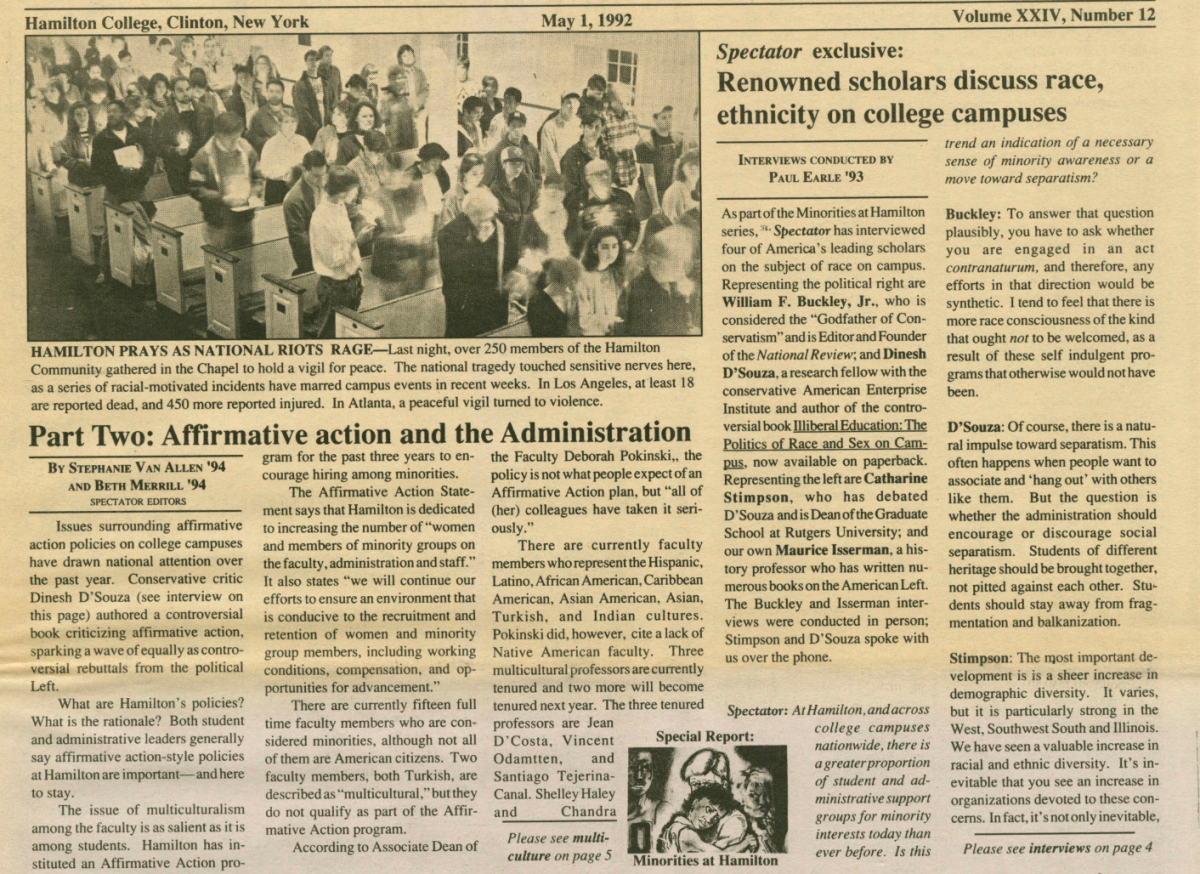
After three years of bouncing between Glenview and both Bundies, I am finally happy with my on-campus housing. Skenandoa House is a comfortable place to live, with a lovely carpeted floor and (mostly) functional air conditioning. We shall see how I find the trek up the Hill once the incline inevitably freezes over, but for now, I am satisfied.
I confess that I had never heard of Skenandoa before my roommate suggested lodging there, and so I spent a considerable amount of time reading up on the dorm before returning to campus this August. Among the details that had eluded me was the house’s original purpose: as a gathering place for the college’s Psi Upsilon fraternity chapter. Psi Upsilon utilized the building for its own purposes as recently as thirty years ago, until a dramatic change in Hamilton’s housing policy. With the Residential Life Decision of 1995, Hamilton mandated that all current and future students live on campus. This mandate theoretically affected any and all students who wished to live outside a Hamilton dorm room, but the school’s unambiguous targets were its fraternities and sororities. Not only did the decree forbid its Greek life organizations from finding room and board off the Hill, but it also unceremoniously kicked them out of on-campus housing, subsequently repurposing the seized buildings for student housing, including my lovely little dorm room.
My gratitude towards the thoughtfulness of the Hamilton administration during the mid-Nineties might be anecdotally confined, but the guiding principles and commitments of the decision — academic integrity and cross-cutting social opportunity — remain as vital to the mission of the American college as ever, if not more so. Consequently, there should be no doubt that the American collegiate system would be substantially better off were it to entirely eliminate all traces of Greek life. Given the already enfeebled state of fraternities and sororities here, Hamilton is in a uniquely privileged position to spearhead such a movement; it is time to take the next step and expel these organizations from the college permanently.
One of the pernicious aspects of Greek life is the shield of philanthropy they use to portray themselves as beneficial to society at large. Indeed, some of these organizations explicitly present their charity fundraising initiatives as their raisons d’être, efforts which are certainly commendable at face value. However, such rodomontade serves to obscure the matter of whether the role they play is one that only they can play. It is naïve at best to uphold the philanthropy of fraternities and sororities as societally important without considering inculcating alternative sources of charity in one’s community, likely without the negative externalities of which Greek life is part and parcel. Since their positive impact is replicable outside of a fraternity or sorority setting, the philanthropic argument they put forward is ultimately a self-serving one, deceptive in the way it frames their purposes.
On a more visceral note, Greek life is also fundamentally dangerous, especially for female students. Alcohol can flow dangerously freely at fraternity and sorority parties, which are responsible, directly or indirectly, for a significant number of what the National Institute on Alcohol Abuse and Alcoholism estimates are over 1,500 college students who die from alcohol-related injuries every year. As if these numbers are insufficiently sobering, the NIAAA also finds that nearly 700,000 assaults take place every year on American college campuses as a result of alcohol consumption. It should also be noted that a significant number of these assaults are of a sexual nature, of which women have historically been and continue to be the primary victims.
Since fraternities and sororities explicitly disallow women and men respectively from joining their numbers, they implicitly mark each other as fundamentally apart, thereby reinforcing a structure of gendered othering. Cross-cutting socialization among members of these groups is thereby largely restricted to party settings, where the combination of this othering and alcohol use creates a staggering potential for sexual violence in a college community. If we collectively care one iota about keeping Hamiton students alive and preemptively keeping them from becoming assault victims, then the continued presence of these organizations on campus is intolerable.
The legacy of Greek life’s ingrained sexism should be especially repulsive to students attending this particular institution; after all, Hamilton is famously two colleges grafted into one. Kirkland College’s 1978 incorporation remains one of the most influential events in Hamilton’s history, as it still exerts a considerable amount of influence over life at Hamilton today (such as in its surviving cultural extracurricular programs at Hamilton, particularly in the world of music). Considering the gendered segregation of Greek life and the astounding quantity of sexual violence such organizations can beget, I fail to see how any self-respecting believer in the equality of all sexes can possibly justify their perpetual presence at Hamilton in particular.
The most repugnant feature of fraternities and sororities, however, is the structural and social elitism that they necessarily uphold. The restrictive processes by which they choose their members allows for them to stifle socioeconomic mobility on campus. Member dues weed out the lower classes from participation, and rushing and pledging allow selective brothers and sisters to segregate the socially awkward and the physically unattractive. There are already scores of articles highlighting the reticence of Greek life organizations to accept members outside of the WASPish crucible in which they were forged, yet even if they were to entirely eliminate these demographic prejudices, the elite social status these organizations confer upon their members would still taint their selection proceedings.
The creation of and access to new, higher social strata that Greek life breeds allows them to exert undue influence over the limited possibilities left for the rest of the student population. If social gatherings are dominated by fraternities and sororities, they are able to explicitly sequester social opportunity from the less financially well-off students at whatever institution they populate. In addition, the networking advantage that fraternities and sororities provide, whereby brothers and sisters can gain a competitive edge in the job market, means that the Faustian bargain of Greek life participation persists long after college graduation, potentially stomping out economic mobility for years into the future. Such an arrangement is morally untenable.
One of the more striking aspects of the Residential Life Decision of 1995 is the number of indignant alumni who indicated their refusal to financially contribute to Hamilton going forward, specifically citing the college’s targeting of Greek life as. I can scarcely imagine more perspicuous proof that these organizations rest squarely within the domain of economic and social anti-egalitarianism, and that a college committed to social and sexual equality, academic seriousness and the breakdown of class barriers must cleanse its campus of fraternities and sororities forthwith.
There can be no doubt the Hamilton would become a materially and morally superior space were it to permanently do away with fraternities and sororities. Through finally ridding this institution of Greek life, every one of its students can look forward to a more auspicious and egalitarian future.














